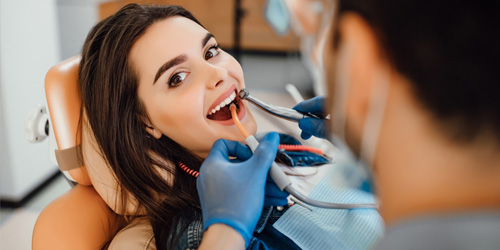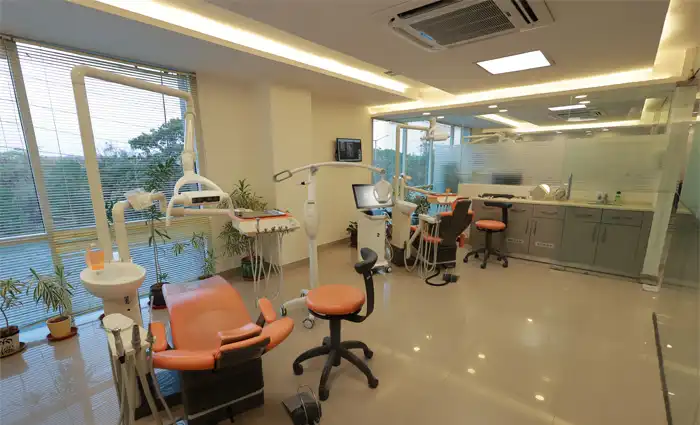The loss of multiple teeth, whether due to age, trauma, or other dental issues, can significantly impact a person’s oral health, confidence, and quality of life. For such individuals, full mouth dental implants can offer comprehensive and permanent restoration.
Full mouth dental implants, also known as full arch implants or full mouth reconstruction, involve the replacement of all missing teeth in the upper or lower jaw with dental implants. These implants serve as artificial tooth roots, providing a stable foundation for prosthetic teeth, bridges, or dentures.
Procedure for Full-Mouth Dental Implant
Full-Mouth Dental Restorations can be done in many ways, but the basic procedure remains the same. The procedure is initiated by extracting all teeth and then fixing the implant on the jaw bones- the number and type of implant may vary based on the technique being followed. Thereafter, the permanent prosthesis is either screwed into the implant or cemented over it. Based on the patients’ preferences, the restorations can be dentures, crowns or bridges.
Important Factors to be Considered
The procedure for full-mouth dental implants can vary widely based on the following factors that need careful consideration:
- The need for additional procedures
- The types of implants
- The implant technique
1. The need for additional procedures
Bone grafting
In addition to teeth extraction, some patients may need augmentation of their jawbone through bone grafting. Their jaw bones may have resorbed due to loss of teeth or gum diseases or prolonged use of dentures, so much that the bone may be inadequate for putting a metal implant. Therefore, bone grafting is done to increase the bone volume. These patients may need additional time for healing before the implants are put. If the implants are fixed onto the basal bone, then bone grafting may be avoided, as the basal bone is resistant to resorption.
Sinus lift
In some patients, the sinuses may be low enough to stand the risk of puncture when the implants are introduced into the upper jaw. So, these patients may need surgical sinus lift. In these patients, additional time may be needed for healing after this surgery. Some implant types, however, can be placed into the jawbone without the need for sinus lift procedure.
2. Type of Implants
Implants are either single-piece or multi-piece implants. Both types have their pros and cons. The type of implants used depends upon the patients’ and doctors’ preferences.
A single piece implant being a single component structure is 3mm and has no joints or a connecting screw, while a multi-piece implant is usually 4mm and can have two or more pieces. Fixing multi-piece implants requires flap surgery, which carries additional costs, risks and healing time, while single-piece implants can be fixed through flapless surgery, there is no need to cut the gum. Single-piece implants are designed especially for immediate loading. As such a permanent crown or bridge is placed in 3 days.
3. Implant Techniques
The implant techniques are based on the number of implants used to support prosthetic restoration. The common ones include:
- Implant dentures with 8 implants full mouth– This full arch dental implants technique requires 2-4 dental implants per jaw. Conventional multi-piece implants are used. In this technique, first the dental implants are installed, and a set of temporary removable dentures are provided. The patient is asked to wait 3-4 months to heal, after which the abutments and fixed on the implants followed by the acrylic denture.
- All on 4 with 4 implants per arch and 8 implants full mouth- This full arch dental implants technique requires 4 dental implants per jaw. Firstly, conventional implants are installed, and temporary removable acrylic dentures are fixed. After a healing period of 3-4 months to heal, the abutments are placed and permanent teeth made of porcelain fused to metal is fixed.
- All on 8 with 8 dental implants per arch and 16 implants full mouth– This full arch dental implants technique requires 8 dental implants per jaw. Firstly, conventional implants are installed, and temporary removable acrylic dentures are fixed. After a healing period of 3-4 months to heal, the abutments are placed and permanent teeth made of porcelain fused to metal is fixed.
- 10 to12 dental implants per arch with 22 implants full mouth- This full arch dental implants technique requires 8-12 dental implants per jaw, including the pterygoid implant. For the procedure, on the first visit, singe piece basal implants are placed and loaded immediately. Thereafter, NexxZr Zirconia bridge with latest CAD/CAM technique is fabricated and fixed in 3 days.
Cost Considerations
Full-mouth dental implant restoration costs vary from one clinic to another based on:
- The type of implants used
- The number of implants needed per jaw
- The need for additional surgeries
- The type of prosthesis and its material
- The number of consultations/sittings needed
Full-mouth dental restoration can be a permanent solution for nagging dental problems. Full mouth restorations can help ensure you have a confident smile and well-functioning set of teeth.





